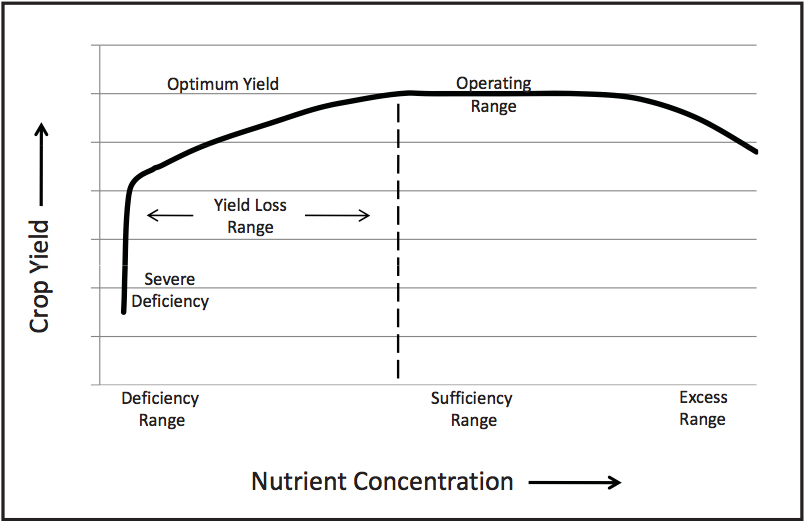Tissue testing and plant analysis date back to the 19th century. Since that time, considerable research has been devoted to refining these tools for assisting farmers to efficiently manage crops. Understanding the relationship between nutrient concentrations in plant tissue and the ultimate yield or quality is fundamental for using this information correctly in the field. The general relationship between plant yield and tissue nutrient concentrations appears in Figure 1.
Plant analysis is commonly used for many valuable purposes, including these agricultural needs:
-
Predicting potential deficiencies in current or future crops;
-
Diagnosing nutrient deficiency, toxicity or imbalances;
-
Predicting the need for various essential nutrients at critical growth stages;
-
Validating the effectiveness of existing fertility programs;
-
Assessing nutrient concentrations in tissue to create nutrient budgets and quantify nutrient removals; and
-
Determining the value of plant material as animal feed.

Figure 1
Monitor nutrient uptake.Avoiding nutrient deficiencies is the best way to maintain yield and quality. A periodic check of plant nutrient concentrations during the growing season helps farmers avoid deficiencies and imbalances before they occur.
Diagnose deficiency.Since all fields vary in soil properties across the landscape, it’s natural that plant growth will also vary across the field. Soil variables include texture and clay content, soil rooting depth, drainage, organic matter content, and so on. Since all of these factors can influence nutrient availability for crops, farmers can’t expect a uniform nutrient supply in the field. When deficiencies first become visible, it’s advisable to take plant tissue samples from both the problem areas and from areas of the field that appear normal. The practice of sampling tissue from both deficient and healthy plants makes it easier to diagnose cause of the problem.
Plan nutrient programs.Regular tissue testing is essential for future nutrient management decisions. For example, if testing reveals low magnesium concentrations in plant tissue, the grower can manage or correct the problem for future crops through soil amendments, fertilizers, foliar nutrition, or possibly switching to an alternate crop.
Consult a tissue specialist.When beginning a tissue-testing program, be certain to consult with a specialist to get the samples taken at the appropriate stage of growth and correct position on the plant, and properly handled for delivery to the analytical lab. Poor sampling practices can make it impossible to interpret the laboratory results and perform corrective action. Building a multiple-year history of plant nutrient concentrations can also help farmers spot emerging problems before they cause yield or quality to decline.
For more information, contact Dr. Robert Mikkelsen, Western North America Director, IPNI, 4125 Sattui Court, Merced, CA 95348.